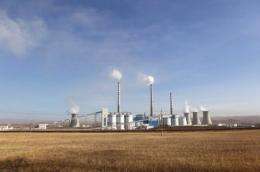An aircraft flies past a smoke-stack in Beijing in May 2012. China's carbon dioxide (CO2) levels soared in 2011, putting its per capita emissions on a par for the first time with those of Europe, while global levels of the greenhouse gas hit another all-time high, a report released Wednesday said.
China's carbon dioxide (CO2) levels soared in 2011, putting its per capita emissions on a par for the first time with those of Europe, while global levels of the greenhouse gas hit another all-time high, a report released Wednesday said.
Last year, China's CO2 emissions rose by 9.0 percent, meaning the country produced the equivalent of 7.2 tonnes of the gas for each resident, according to the report by the Netherlands Environmental Assessment Agency and the European Commission's Joint Research Centre.
The 27-nation European Union produced 7.5 tonnes of CO2 per person, while the United States remained one of the world's top CO2 emitters, with 17.3 tonnes per resident in 2011.
China and other fast-growing economies like India fear emissions curbs would slow their development, so have sought concessions in international climate deals.
They argue that as developing nations with lower per capita emissions than the industrialised world, they should not be subject to the same CO2 restrictions as advanced economies.
Overall, global carbon dioxide emissions increased by three percent to reach a record level of 34 billion tonnes, the report said.
The rise is a similar level to the 10-year average of 2.7 percent. Levels dipped slightly in 2008 due to the onset of the global economic crisis but bounced back to surge by five percent in 2010.
Smoke emits from chimneys at a coal mine in China in 2010. China's carbon dioxide (CO2) levels soared in 2011, putting its per capita emissions on a par for the first time with those of Europe, while global levels of the greenhouse gas hit another all-time high, a report released Wednesday said.
Still, CO2 emissions from the US and Japan dropped about two percent last year, thanks largely due to weak economic conditions, mild winters and high oil prices.
The surge in China's CO2 emissions was driven mainly by its continued high economic growth rate and the accompanying thirst for fossil fuels, the report said. China's coal imports surged by 10 percent, making it the world's largest coal importer.
The United Nations has adopted a target of limiting global warming to 2.0 degrees Celsius (3.6 Fahrenheit) by 2050.
Scientists think this is feasible as long as cumulative CO2 emissions between 2000 and 2050 do not exceed 1,000 to 1,500 billion tonnes.
Since 2000, human activities have led to about 420 billion tonnes of CO2 being sent into the atmosphere, and on current trends the ceiling will be breached "within the next two decades," the report warned.
In volume terms, China and the United States are the No. 1 and No. 2 world emitters, accounting for 29 and 16 percent of global CO2, it said. They are followed by the EU (11 percent), India (six percent), Russia (five percent) and Japan (four percent).
(c) 2012 AFP























